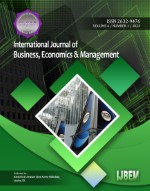Empowering model learning English test for economic students
Keywords:
Average model, high model, low model, model learning, moderate model, offline and online learningAbstract
This study aimed to find out which one was the best learning model for implementing the mid-semester exam and final semester exam model in class for economics students during online class and offline classes at Universitas Pendidikan Nasional. This research was a descriptive study. The subject selection technique used purposive sampling to obtain creativity data from seventy-two students with empowering abilities in the active Model learning process. The findings of this study indicated that the students surveyed did not take their class tests seriously. Few of them take it seriously since they don't know how to study in college yet. During the test, most students had no idea what to do because the lecturer's content from class directed them. Therefore, it’s important to note that the different levels of thinking defined within each domain of the Taxonomy are hierarchical. These two levels were significant in mastering the subject matter in the classroom. Students needed to be well informed on the proper model to use while taking class assessments.
Downloads
References
Ahmad, A. (2022). Management strategies of school principles in developing teachers’ professional competency to improve the quality of education in SMK Kesehatan Darus Salam Lhokseumawe Aceh. International Journal of Business, Economics & Management, 5(3), 238-245. https://doi.org/10.21744/ijbem.v5n3.1960
Brown, H. D. (2000). Principles of language learning and teaching (Vol. 4). New York: Longman.
Brown, H. D. (2002). Strategies for Success: A Practical Guide to Learning English. Addison Wesley Longman, Inc., a Pearson Education Company, Order Processing Center, PO box 11071, Des Moines, IA 50336.
Brown, H. D., & Abeywickrama, P. (2004). Language assessment. Principles and Classroom Practices. White Plains, NY: Pearson Education.
Farchi, A., Bocquet, M., Laloyaux, P., Bonavita, M., & Malartic, Q. (2021). A comparison of combined data assimilation and machine learning methods for offline and online model error correction. Journal of computational science, 55, 101468. https://doi.org/10.1016/j.jocs.2021.101468
Finocchiaro, M., & Sako, S. (1983). Foreign Language Testing: A Practical Approach. Regents Publishing Company, Inc., 2 Park Ave., New York, NY 10016.
Fryer, L. K., & Bovee, H. N. (2016). Supporting students' motivation for e-learning: Teachers matter on and offline. The Internet and Higher Education, 30, 21-29. https://doi.org/10.1016/j.iheduc.2016.03.003
Fulcher, G. (2012). Assessment literacy for the language classroom. Language Assessment Quarterly, 9(2), 113-132.
Groundland, N. E. (1984). Constructing achievement test. New York. Prentice Hall.
Hughes, A. (2003). Testing for language teachers. Cambridge university press.
Lee, M. C. (2010). Explaining and predicting users’ continuance intention toward e-learning: An extension of the expectation–confirmation model. Computers & Education, 54(2), 506-516. https://doi.org/10.1016/j.compedu.2009.09.002
MacWhinney, B., & Leinbach, J. (1991). Implementations are not conceptualizations: Revising the verb learning model. Cognition, 40(1-2), 121-157. https://doi.org/10.1016/0010-0277(91)90048-9
Patrick, H., Ryan, A. M., & Kaplan, A. (2007). Early adolescents' perceptions of the classroom social environment, motivational beliefs, and engagement. Journal of educational psychology, 99(1), 83.
Primadani, A. E. (2013). An analysis of midterm English test of the 7th grade accelerated class at SMPN 3 Malang (Doctoral dissertation, Universitas Negeri Malang).
Ratnafuri, W. F. (2011). An Analysis of the teacher-made english test in the final test of the 2nd semester of 2010/2011 of the first year student of SMPN 1 Kauman, Tulungagung (Doctoral dissertation, Universitas Negeri Malang).
Rudner, L. M., & Schafer, W. D. (2002). What teachers need to know about assessment.
Setiyana, R. (2016). Analysis of summative tests for English. English Education Journal, 7(4), 433-447.
Soleimani, A., Araabi, B. N., & Fouladi, K. (2016). Deep multitask metric learning for offline signature verification. Pattern Recognition Letters, 80, 84-90. https://doi.org/10.1016/j.patrec.2016.05.023
Song, L., Singleton, E. S., Hill, J. R., & Koh, M. H. (2004). Improving online learning: Student perceptions of useful and challenging characteristics. The internet and higher education, 7(1), 59-70. https://doi.org/10.1016/j.iheduc.2003.11.003
Sugianto, A. (2017). Validity and reliability of English summative test for senior high school. Indonesian EFL Journal: Journal of ELT, Linguistics, and Literature, 3(2), 22-38.
Too, E. C., Yujian, L., Njuki, S., & Yingchun, L. (2019). A comparative study of fine-tuning deep learning models for plant disease identification. Computers and Electronics in Agriculture, 161, 272-279. https://doi.org/10.1016/j.compag.2018.03.032
Van Popta, E., Kral, M., Camp, G., Martens, R. L., & Simons, P. R. J. (2017). Exploring the value of peer feedback in online learning for the provider. Educational Research Review, 20, 24-34. https://doi.org/10.1016/j.edurev.2016.10.003
Wasserman, L. (2000). Bayesian model selection and model averaging. Journal of mathematical psychology, 44(1), 92-107. https://doi.org/10.1006/jmps.1999.1278
Wulandari, D. T. (2017). Classroom Assessment Techniques (CATs) Used By The English Teacher On The Tenth Grade at SMA Muhammadiyah 1 Malang (Doctoral dissertation, University of Muhammadiyah Malang).
Zhang, Z., Li, J., Zhao, X. Q., Wang, J., Wong, G. K. S., & Yu, J. (2006). KaKs_Calculator: calculating Ka and Ks through model selection and model averaging. Genomics, proteomics & bioinformatics, 4(4), 259-263. https://doi.org/10.1016/S1672-0229(07)60007-2
Published
How to Cite
Issue
Section
Copyright (c) 2023 International journal of business, economics & management

This work is licensed under a Creative Commons Attribution-NonCommercial-NoDerivatives 4.0 International License.
Articles published in the International Journal of Business, Economics & Management (IJBEM) are available under Creative Commons Attribution Non-Commercial No Derivatives Licence (CC BY-NC-ND 4.0). Authors retain copyright in their work and grant IJBEM right of first publication under CC BY-NC-ND 4.0. Users have the right to read, download, copy, distribute, print, search, or link to the full texts of articles in this journal, and to use them for any other lawful purpose.
Articles published in IJBEM can be copied, communicated and shared in their published form for non-commercial purposes provided full attribution is given to the author and the journal. Authors are able to enter into separate, additional contractual arrangements for the non-exclusive distribution of the journal's published version of the work (e.g., post it to an institutional repository or publish it in a book), with an acknowledgment of its initial publication in this journal.














